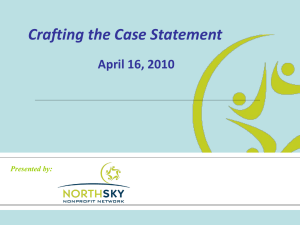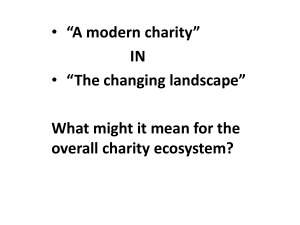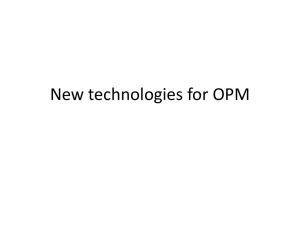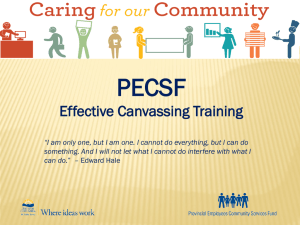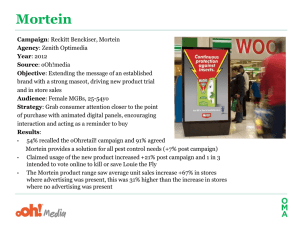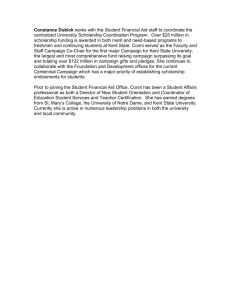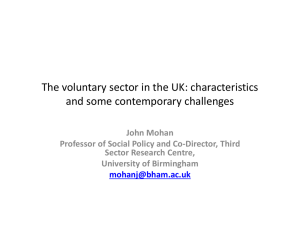Talking Points with Examples and Questions
advertisement
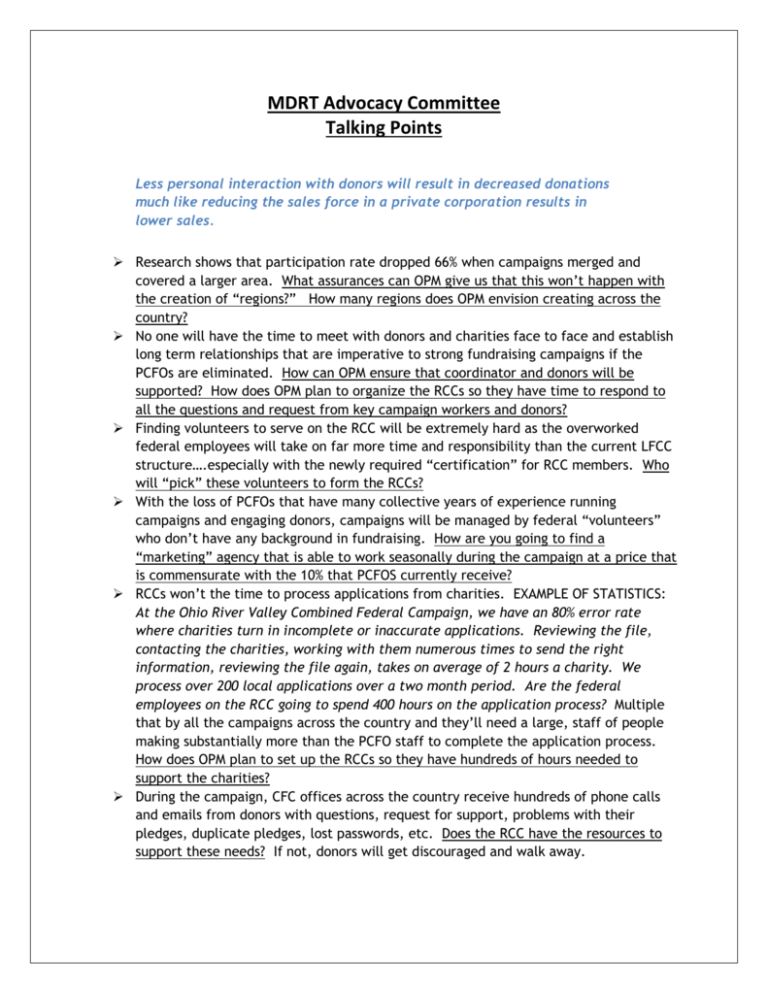
MDRT Advocacy Committee Talking Points Less personal interaction with donors will result in decreased donations much like reducing the sales force in a private corporation results in lower sales. Research shows that participation rate dropped 66% when campaigns merged and covered a larger area. What assurances can OPM give us that this won’t happen with the creation of “regions?” How many regions does OPM envision creating across the country? No one will have the time to meet with donors and charities face to face and establish long term relationships that are imperative to strong fundraising campaigns if the PCFOs are eliminated. How can OPM ensure that coordinator and donors will be supported? How does OPM plan to organize the RCCs so they have time to respond to all the questions and request from key campaign workers and donors? Finding volunteers to serve on the RCC will be extremely hard as the overworked federal employees will take on far more time and responsibility than the current LFCC structure….especially with the newly required “certification” for RCC members. Who will “pick” these volunteers to form the RCCs? With the loss of PCFOs that have many collective years of experience running campaigns and engaging donors, campaigns will be managed by federal “volunteers” who don’t have any background in fundraising. How are you going to find a “marketing” agency that is able to work seasonally during the campaign at a price that is commensurate with the 10% that PCFOS currently receive? RCCs won’t the time to process applications from charities. EXAMPLE OF STATISTICS: At the Ohio River Valley Combined Federal Campaign, we have an 80% error rate where charities turn in incomplete or inaccurate applications. Reviewing the file, contacting the charities, working with them numerous times to send the right information, reviewing the file again, takes on average of 2 hours a charity. We process over 200 local applications over a two month period. Are the federal employees on the RCC going to spend 400 hours on the application process? Multiple that by all the campaigns across the country and they’ll need a large, staff of people making substantially more than the PCFO staff to complete the application process. How does OPM plan to set up the RCCs so they have hundreds of hours needed to support the charities? During the campaign, CFC offices across the country receive hundreds of phone calls and emails from donors with questions, request for support, problems with their pledges, duplicate pledges, lost passwords, etc. Does the RCC have the resources to support these needs? If not, donors will get discouraged and walk away. Limiting donors to only online donations and eliminating all paper pledges, check and cash donations will result in lower donations. Federal agencies won’t be able to hold fundraising events such as chili cook offs, dress down days, etc. where they raise awareness as well as thousands of dollars in donations. EXAMPLE OF STATISTICS FROM LOCAL CAMPAIGN: The Ohio River Valley CFC captured $141,837 in cash and check pledges in 2012, which is 12% of total pledges. The campaign will lose all or a majority of these pledges, especially considering more than $94,000 was collected from special events in the 2012 campaign. With less local support, less fundraising expertise, no food or beverages provided per OPM regulation, and no special fundraising events, how does OPM propose to reach and engage donors? Doing away with a paper pledge option would be a huge shock to donors who have been filling out their pledge forms for years. Some will not pledge at all and some who make the attempt but find it hard to use the system or find their charity, will get frustrated and give up. Best practice fundraising techniques require that making a donation has to be easy for the donor and there has to be several ways to give donations that each donors feels comfortable with. EXAMPLE OF STATISTCIS FROM LOCAL CAMPAIGN: The Ohio River Valley CFC captured $403,302(37%) in online pledges and $709,864 (63% ) in paper pledges in 2012. The campaign risks losing a major of these paper pledges when the regulation changes go into effect (assuming a small minority of former paper pledge donors will convert to giving online). Does OPM have a way to make up for the loss of paper pledges? Federal employees without access to computers or are forbidden to give online because of security reasons, will not be given the opportunity to donate which is counter to the Executive Order that says all federal employees have access to give. Research shows most will not go home and use their personal computer to participate in a workplace giving program. How are employees without access to computers supposed to make an online pledge? MDRT supports the growth of online giving systems but having that the only option is counterproductive. Does the cost savings envisioned by OPM outweigh the loss of donations? Cost of creating one new national website and supporting donors and charities using the website are unknown and may result in higher costs. What is the cost of this giant website? Who is going to support the users—both donors and charities? How much time does OPM envision this will take? Federal workplaces benefit with strong campaigns We go into the federal agencies during campaign and see clear and compelling evidence that having a strong Combined Federal Campaign results in higher morale for the federal employees who manage and participate in the campaign. EXAMPLE OF QUOTE: In fact more than one federal employee has said to me, “Running the Combined Federal Campaign is the best part of the work year for me. I love seeing how all my coworkers rally around the great causes supported by the Combined Federal Campaign.” Research shows that people feel good when they donate and we can see that and the team building and camaraderie that goes on at an event or Kick Off and throughout the campaign. At a time when morale is at an all time low, is it wise to take away yet another opportunity for federal employees to get excited about something at work? Emerging leaders get an opportunity for free professional development outlined by OPM directives by working as a Loaned Executive and/or campaign coordinator. They learn project management, marketing, team building skills which have resulted in promotions and recognition. EXAMPLE OF PERSONAL STORY: Last year, my loaned executive did such a great job with her project that her boss noticed and she was promoted.” Without Loaned Executives and PCFOS, who is going to do all the work required to run the campaign? Donors will have fewer charities to choose from if charities are required to pay an application fee. Early research estimates 40% of charities will drop out after deciding the return on investment is too low if required to pay a fee upfront because: Only big/elite charities will be able to afford the fee which may be in the range of $3000-$5000 per national federations/charity. There was no figure given for local charities mentioned by OPM but to cover 100% of the campaign costs of $25,000,000 to manage the campaign, each of the 25,000 charities would have to pay $1000? Most local charities don’t receive that much in designated funds and would stop applying. Current charities would have to pay the annual fee twice before they even know the amount of the first campaign’s donations. Charities would have to pay the fee without knowing how much they get as donations fluctuate from year to year. New charities will be less likely to apply as they receive fewer dollars the first few years to get established with federal donors. As charities drop out, the remaining charities will have to pay more to cover the costs of the campaign. How much are the charities required to pay? Is it a sliding fee? Does OPM hope to collect the projected $20,000,000 it takes to run the one national campaign? Will charity fees increase as more and more charities drop out of the CFC? A smaller charity list means donors will less likely find their “favorite” charity resulting in them deciding to donate directly to the charity. If they follow through, they will make a onetime donation as they won’t have the option to make a payroll pledge. It is unlikely that one time donations are going to be as large as a recurring payroll pledges resulting in less revenue for the charity. Early feedback from charities indicate they strongly oppose paying a fee upfront and would rather continue the practice of having fees come out of their total donations following the campaign based on the percentage of donations they receive. Is OPM prepared to run a successful campaign with substantially fewer charities? If the reason to make charities pay a fee upfront is to make donors feel like 100% of their donation is going to the charity, donors will eventually see through the smoke and mirrors and understand that charging charities an application fee upfront is just another way that their donation is being used for overhead. Most donors understand that it costs money to make money, i.e., charity vetting, campaign audits, campaign materials, website, software, etc. Final Comments Some of OPM proposed changes are sound (allow new employees to make pledges immediately, universal giving so a donor could donate their money to any charity across the country, establish pre-emptive voluntary disaster relief plan, improve payroll center processes, waive audit requirement for small charities, increase federations transparency to donors, not requiring a full charity application each year…) Expenses may go down at first, but revenue will go down even more resulting in higher expense than the current 10% overhead which is well below the average cost of fundraising in the private sector. Combined Federal Campaigns made 95% of their fundraising goals in 2012 and in this uncertain economy that is to be applauded. Private sector nonprofits are seeing much more decline in their donations. These proposed regulations are not based on the recommendations from the CFC 50 Commission. Some members of the Commission are dismayed that OPM has touted that their proposed regulations came from the Commission’s recommendations. OPM has gone way beyond what was recommended and some of the best recommendations that came from the Commission were ignored. Has OPM received comments back from the commission supporting the regulation changes? If the OPM proposed regulations go forward as written, the Combined Federal Campaign will be so crippled that there will be a time where there will be no workplace giving program for the largest workforce in the world ---federal employees. In the end, these changes will put more burden on government funded programs because charities will be able to serve less people. Does OPM want to end the Combined Federal Campaign?
